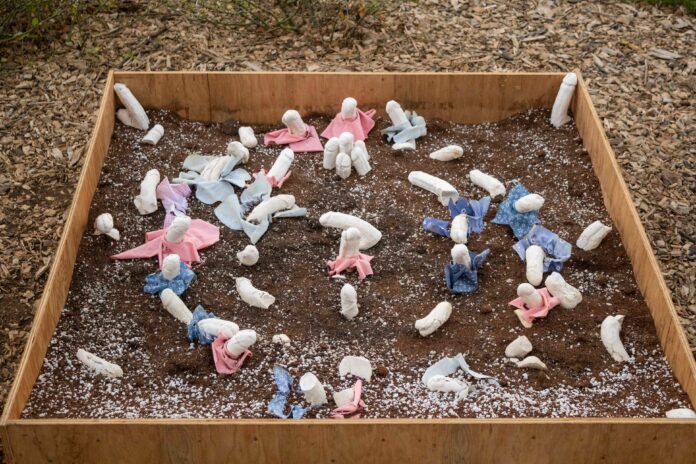‘My Vagina’ piece a part of the installation project for ART 151
Kaiden Zaldumbide’s art piece was the talk of the town on the UC Davis campus. A box of penises laid planted in dirt and left on display outside Peter J. Shields library. At first glance, it seemed like a joke — why would numerous phallic sculptures be lying around the study sanctuary?
The piece’s statement reads: “I am a transgender male and I experience gender dysphoria. But no one has ever asked me where I experience it.”
“The ‘My Vagina’ piece was a part of the installation project for ART 151, the intermediate studio sculpture class,” explained Zaldumbide, a second-year studio art major.
The project was to make 100 copies of an object. Originally, he was going to copy the image of a tampon to represent gender inequality from the period tax.
“I suddenly got the idea to use this packet I had gotten for free at the LGBTQIA Resource Center, and I don’t know why, but it just suddenly clicked,” Zaldumbide said. “I got really excited about it, and I was like ‘I wanna do 100 d-cks!’”
“Let me turn the prime symbol of masculinity and turn it into something viewed typically as gender neutral or a more feminine sense,” he continued.
Zaldumbide crafted the penises into flowers as a way to reshape society’s conventional perspective of gender. The original color of the piece was a baby blue color which, from feedback, made viewers associate the piece to a child’s sandbox.
“I very easily made a wooden box and I just bought dirt and planted [the penises], and I spent an entire night sewing them with flower petals so that it looked more like a garden. It did a real number on my fingers,” he said with a chuckle.
“I found it rather funny that people were actually playing with the [piece],” Zaldumbide said. “Part of our assignment was to maintain it, and I would have friends saying that they would see people messing with [my art]. I feel like I should be offended, but at the same time, that’s funny. That just brings out such an inner level of childness that you could just play with it and you don’t even read what it’s about.”
Besides being a new piece of playground equipment, Zaldumbide shared what he wanted passersby to take away from the piece.
“The most important part of my piece is that I just wanted to mainly share a story,” Zaldumbide said. “I have always seen art as a way to tell a story whether you want to use that for political action or something towards the feminist movement or just something for entertainment reasons.”
“That is kind of what I wanted to do, I just wanted to tell my story and to show people an insight on what it is like to be transgender,” he continued. “One, it is a very unique experience, and two, it is a very hard experience to try and understand and empathize with. [Being transgender] is completely foreign to cis[gender] people. I want to share who I am and the way I have grown up. How it is sort of isolating to feel like gender norms were pushing me to feel a certain way and me not realizing that it is okay to feel different and otherwise.”
He explained further, saying he wanted others to realize “there are a lot of different faces to the transgender experience.”
“None of them are inherently correct, but they’re all extremely personal and individualized,” Zaldumbide said. “If you don’t understand it, it’s okay because it is not always easy to understand.”
Zaldumbide explained how he received emails from transgender men telling him how beautiful his piece was and how much they could relate to his experience. He was so moved that his piece had told a story, had reached a community and touched the hearts of others.
“I feel like the role of genetalia and its connection to gender norms in society is very archiac and very dumb and unecessary,” Zaldumbide said. “[Genitalia] don’t better you in any way, they don’t need to be defining characteristics. Even though it can, I don’t feel like it should be playing a role in gender.”
“I feel like gender is your experience, your identity and how a person individually sees the world,” Zaldumbide explained. “It is something very customizable. I feel like gender is very lucid and very much what each person chooses for themselves, and it shouldn’t necessarily be something that has a definiton or link, especially to sex.”
He explained his own experience with gender dysphoria and what he has struggled with as a transgender men, such as the pitch of his voice or the round shape of his face.
“Talking about the transgender experience, there is this general idea that everything femenine about you is what’s causing this dysphoria and this distress, but that’s not always true,” Zaldumbide said. “For me, personally, it has never been the fact that I am feminine, it is always certain aspects of my femininity that don’t make me feel like a man that affect me.”
The art piece was on display during Fall Quarter 2019 — “I did something good,” Zaldumbide said of it.
Written by: Sierra Jimenez — arts@theaggie.org




